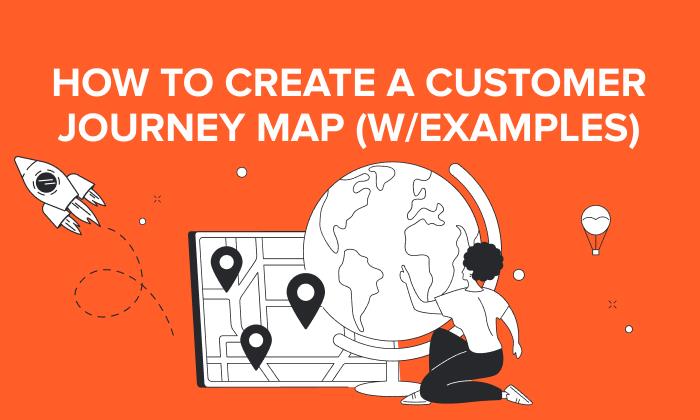
Creating a customer journey map is enough to make even the best marketers freeze in their tracks and realize how little they really know about their prospects.
If this sounds like you, don’t worry.
Even if you’ve never created a buyer persona before, I’ll help you make sense of the process by giving you a guide to better understand who your customers are and what they want.
Let’s take a closer look.
What Is A Customer Journey Map?
A customer journey map is a diagram that illustrates each step in the buyer’s journey, including who the customer is, what their needs are, and what objections they may have.
This map makes it easier for sales, marketing, and executive teams to make more informed decisions while humanizing your audience and making them easier to target.
The first step in a customer journey map is the core demographics, such as:
- Gender
- Age range
- Job title
- Job responsibilities
- Salary
- Region
- Company size
You’ll likely find most of this data in your CRM. If not, a survey can give you a clear picture of who your audience is and what they do.
I recommend “humanizing” the persona by giving them a name and image. This brings out more of our emotional, empathetic side versus looking at the potential customer as a number to slot somewhere in a sales funnel.
Different Stages of the Customer Journey
When mapping out the customer journey, there are different stages that businesses need to be aware of. By understanding these stages, companies can create a more seamless and effective map that leads to conversions and customer satisfaction.
Let’s take a look:
Awareness Stage
The customer journey map begins with awareness, which means when the prospect becomes aware of your product or service.
They may see an ad, read an article online, or hear about your business from a friend at this stage.
Comparison Stage
This is when customers look at the various options and compare them side by side. Typically, they look at features, prices, and reviews to decide which product is right for them.
The comparison phase is crucial because it’s where customers make their final decision. If you can influence them during this part, you can increase your chances of making a sale.
Decision Stage
The decision stage is the final stage of the customer journey map when the customer either makes or does not make a purchase. Many factors, such as price, product quality, and customer service, influence the decision stage.
Now that you have the basics, let’s see what this looks like in practice.
Customer Journey Map Example
For our customer journey example below, we’ve chosen to work with Lucy, a marketing director in her late 40s.
Her job primarily entails lead generation, sales management, and gathering competitive intelligence.
She organizes and prioritizes campaigns; she’s a pro at gathering competitive intelligence and uses it wisely to reinforce the brand while cementing customer loyalty in a highly competitive marketplace.
Due to the increase in popularity of social media, Lucy’s looking to streamline the interaction process on social media without losing the “personality” of the brand.
She’s in the market for a solution and wants to make a confident decision quickly.
With this in mind, our persona map looks something like this so far:

Now we’ve got a persona, what about the buyer’s needs?
How To Understand the Buyer’s Needs
Buyers are eager to tell you what they need. All you have to do is ask.
Basic lead follow-up and nurturing questions can reveal quite a bit. Additionally, simple polls and surveys can often show a great deal about where the buyer is in the process (and whether they have an urgent need for your product or service versus basic curiosity).
Even if we don’t know specifically what they need, we can make a few general statements and apply them to our persona.
Returning to the example above, ask yourself, what would someone in this job typically need from our solution?
- For starters, the buyer likely needs the product to be well-documented. She’ll be managing dozens, perhaps hundreds, of staff members, some of whom may be more technically savvy than she is.
- Some staff may pick it up quickly; others may need more time. We’ll add the needs and the persona’s place in the decision-making process (one persona can have multiple roles in the decision process; they can be a user and initiator, for example)
- Is the solution adaptive and flexible to accommodate the buyer’s existing platforms and tools?
- Does the purchaser have procedures and requirements to add to the mix, like cloud-based access and specific security protocols?
- These factors can influence and even conflict with what the primary buyer wants.The internal stakeholders often make decisions like these, which lengthens the required time and features.
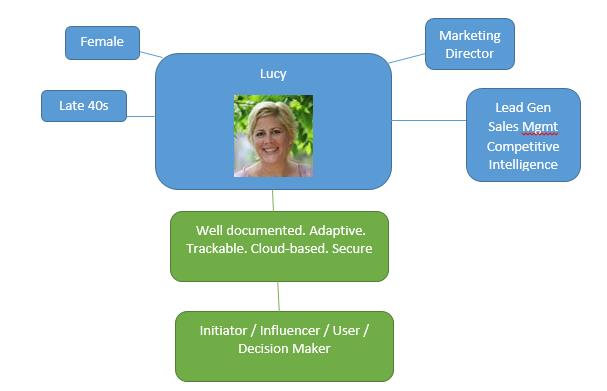
Dealing with Common Roadblocks in Customer Journey Maps
During the customer journey, constraints, concerns, frustrations, and issues often affect the buying decision. These roadblocks will prevent your customer from taking action, so you need to outline those in your map.
You can brainstorm these obstacles and add them to your customer journey map to ensure that your sales team knows how to address the most common objections before becoming major pain points.
You also have to decide where this buyer falls on the decision-making scale.
Will they be using the product, influencing the decision-maker, or perhaps just initiating contact with the company? Could they be a mix of all of these?
On your map, note these roadblocks and the buyer persona’s place in the decision-making cycle.
Following our example, we end up with something like this:
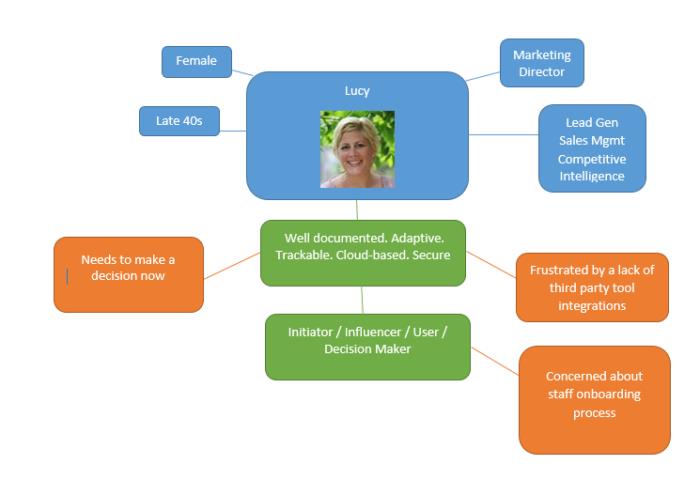
Here, we’ve managed to discover (and brainstorm) the buyer’s potential:
- Needs
- Concerns
- Frustrations
- Urgency/Timeframe to Buy
- Place in the buying cycle
- Requirements
As the list above shows, all the kinds of sales-propelling information needed to acknowledge objections, concerns, and frustrations while concentrating on needs, requirements, and urgency.
We’ve learned core demographics about our buyers and key information that may prevent them from taking action or details that could move a sale into the next stage.
Our customer journey map is less of a neatly-organized, bulleted list and more like a mind map that’s always being adjusted and revised. It may not be as tidy, but it’s closer to the actual customer experience and, therefore, far more useful
In other words, our customer journey map puts you in the buyer’s shoes. The buying decision is rarely a simple one, and the model we’ve designed allows a more accurate look at how people think when planning a purchase.
Create a Customer Journey Map for Each Type of Customer
Now, you must go through this entire process with every type of buyer your company encounters. Each type of customer will have a different buyer path, objections, and challenges. For example, in retail, you’ve got suppliers, wholesalers, resellers, and a whole avalanche of personas out there.
Need some inspiration? Here are some customer journey map examples:
You can break customer journey maps into smaller parts for more complex situations and focus on different areas, like the e-commerce checkout process.
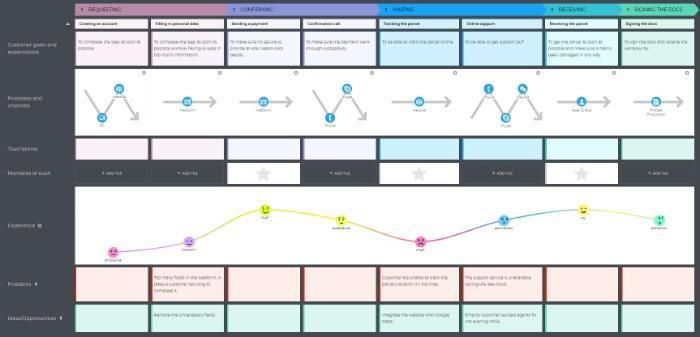
Another approach is to create a customer journey map for specific features like Spotify did.
Spotify wanted to track playlist-creation touchpoints through a third-party app to understand customers’ emotions better.
By using customer journey mapping, Spotify found its users were reluctant to share their playlists in case others judged their musical tastes. Additionally, Spotify found some users didn’t know about the feature.
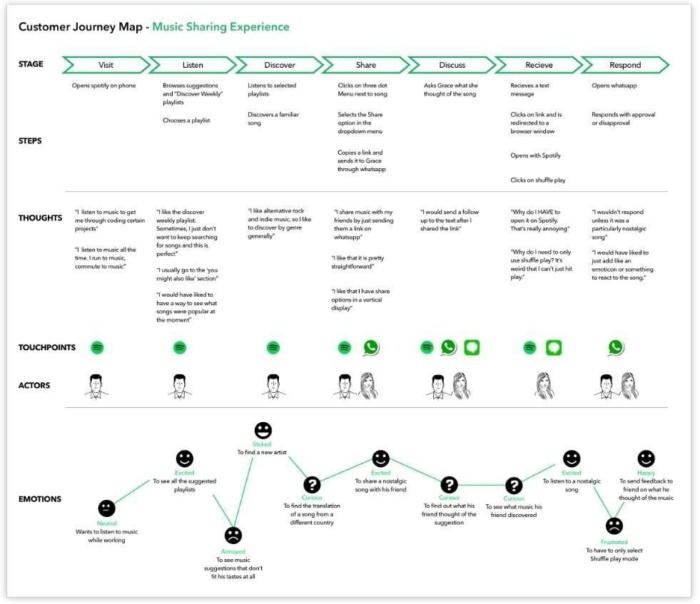
Spotify responded to this by improving its user interface and in-app flows to refine the customer experience and improve touchpoint relevance along the way.
The above are just two customer journey map examples; buyer journeys are also a key part of PPC campaigns.
The Customer Journey and Your Marketing Strategy
As a business, you want to ensure that your marketing strategy aligns with your customer’s journey. Here are some steps to help you do that.
First, you’ll need to identify your customer’s various touchpoints with your brand. This could include everything from visiting your website to speaking with customer service.
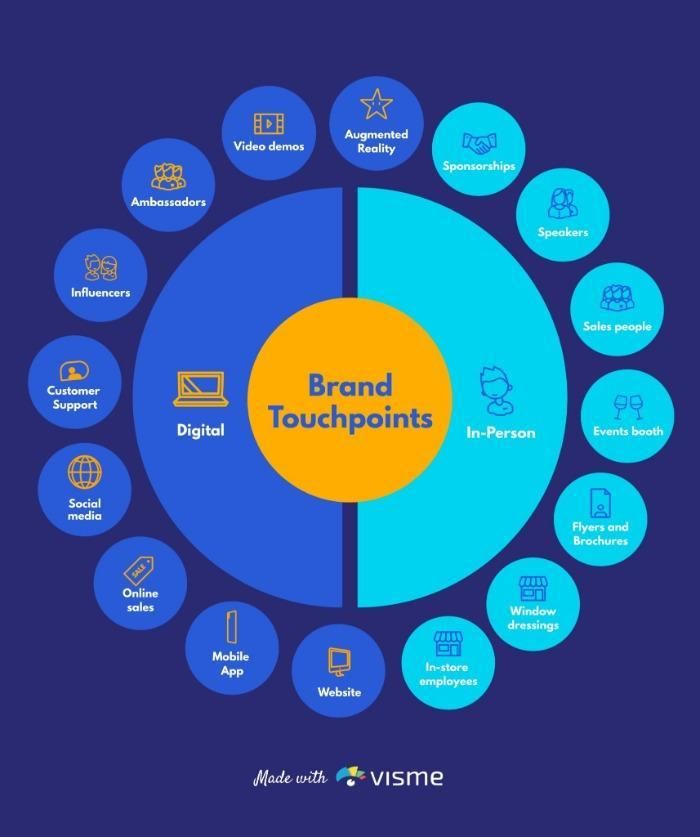
You can use marketing attribution (the process of measuring which specific marketing activities are driving results for your business) to help you identify these touchpoints.
Next, you’ll consider the customer’s emotional state at each journey stage. What do they need? Answering these questions will help you create a more effective customer journey map.
Finally, don’t forget to consider the overall purpose of the customer journey map and how it ties in with your market strategy. What do you want your customers to achieve? Once you have a clear goal, you can start mapping out the steps needed to get there.
Customer Journey Maps and Content Creation
Creating content for each stage of the customer journey is an effective way to guide your prospect all the way to the purchase point.
By providing helpful, informative, and engaging content, you can keep your customers engaged and nurture them to become lifelong fans of your brand.
I’ve listed some content ideas for each stage of the journey.
The Pre-purchase (Awareness) Stage
The pre-purchase stage is all about education. Your potential customers are trying to learn more about their options and what would be the best fit for them. They’re looking for unbiased information to help them make a decision.
That’s where your content comes in. Providing them with helpful information that answers their questions helps them narrow down their options and make informed decisions.
Types of content you could create include:
- Blog posts
- Social media content
- Ebooks
- Case studies
The Consideration Stage
During the consideration stage, your customers make up their minds about which product or service to choose. They’re looking for reassurance that they’re making the right choice. How can you help them along? Try content like:
- Product comparisons
- Ebooks
- Blog posts and videos explaining more about the product
- Email marketing (Focusing on the product/service your lead is interested in).
The Purchase Stage
Your prospect is about to make their decision but might have some doubts. What content can you give them that may get them over the line and turn them into a fully-fledged customer? Try:
- Product information guides
- FAQs
- Pre-sale support through email, chat, and social media
- Email marketing
Finally, remember to look after your customer post-purchase. Ensure your client gets the best from the product/service with how-to guides, product updates, and access to customer service support.
FAQs
What Is a Customer Journey Map?
A customer journey map is a diagram that shows the steps a customer takes during their journey with a company. It includes all touchpoints where the customer interacts with the company, from first contact to post-purchase follow-up.
What is Customer Journey vs Customer Experience?
The customer journey represents all the summed up actions and interactions that a customer has with a given brand. The customer experience represents how a business interfaces with customers at every touch point. So customer experience plays a big role in the customer journey, but the two things aren’t the same.
What Are the Most Common Customer Journey Stages?
While your team may add additional steps depending on your market and audience, the most common customer journey steps are:
- Awareness
- Consideration
- Purchase
- Retention
- Advocacy
What Are the Five Reasons to Use a Customer Journey Map?
Five reasons to use a customer journey map include:
1. Improved communication with customers.
2. Better understanding of customer needs.
3. Identifying potential problems before they happen.
4. Taking a proactive approach to customer service.
5. Saving time and money by resolving issues quickly.
What Should A Customer Journey Map Include?
First, it should clearly outline the various touchpoints a customer has with your brand, from initial awareness to purchase and beyond.
It’s also important to consider the emotions and needs of customers at each stage of their journey. What are they trying to accomplish? What are their pain points? Addressing these questions will help you create a holistic view of the customer experience.
Finally, don’t forget to include data! Collecting data points at each stage of the customer journey will give you valuable insights into your customer demographics and how best to market to them.
Conclusion
Don’t panic. Prioritize.
Focus on your most profitable customers first and find the unifying threads that tie them together, then build on that persona. Once you have those, start working down the list until you have all your customer journeys mapped.
Additionally, remember that buyers are multi-faceted human beings.
Sometimes they make decisions that go against the grain of even the most well-developed persona. It happens.
However, when you have a better idea of who your customers are, you can build more effective conversion funnels that make it easy for buyers to take the action you want them to take.
Are you planning to create a customer journey map? What is holding you back?
Frequently Asked Questions
How to Motivate yourself as an Entrepreneur
Find someone to motivate you. Ask someone who is working hard to achieve his goals how he did it.
Ask for advice, listen to others, and then, most importantly, do it. Follow the example of someone who is successful.
Do whatever it takes to become that person. Take their advice. Take notes. Follow their example.
Keep moving. Keep moving. Never stop learning. Never give up.
Never allow anyone to tell you that your abilities aren't possible. Don't listen to anyone who tells you there is no path.
You may fail, but that doesn't mean you've failed. Failure is an opportunity that can help you grow. To learn more. To push harder.
Failure is only another step on your journey to success.
Let's get started! Get started today and you will be closer to your goals.
Why wait?
What are the 3 motivators of an entrepreneur
Entrepreneurs' three greatest motivations are freedom and money.
- Freedom means the freedom to do anything you want at any time. This is why entrepreneurs can be free from the constraints of our job or current life.
- It is important to have money. Without it, we wouldn't even think about starting a business. Although we can survive without food and water, we cannot live without money.
- Knowledge is the third motivation. Entrepreneurship demands that we constantly learn. This is why we read books, attend seminars, take online courses and learn how to create products.
This is what makes us succeed and helps us achieve our goals. It gives us purpose, meaning.
These three things are the reasons why we became entrepreneurs in the first place. They are the main drivers that keep us going day after day.
We might consider packing up and moving home if these three essentials are not available. We won't be truly happy if we don't have the three things we need.
What are the 6 most important questions that motivate an entrepreneur?
Motivation is the key ingredient to any business. Without motivation, you will not get out the door each day. You'll have trouble completing projects without motivation. You can't reach your goals without motivation. So, how do we find our motivation?
You might ask, "What motivates you?" The answer may surprise you. Maybe you've been asking yourself this same question for years. You are missing one of the greatest rewards of life--the chance to discover your motivation.
Nothing is more motivating than knowing why you exist. That's when you finally begin to realize what drives you. This is when your purpose becomes clearer, more meaningful. Why are you caring? It will be much easier to stay motivated once you understand this.
Finding your motivation starts with looking within. These are your questions:
- What are my passions?
- What makes my heart beat quicker?
- What is it that lights me up?
- What gives me butterflies in my stomach?
- What makes you feel alive to me?
- What keeps you coming back to your projects again and again?
Once you know your answers, you'll be able to identify your true motivations.
You can find your motivation to get through tough times. It will give you strength when you need it. It will make you work harder. It will help you achieve success.
And if your like me, then you'll never stop trying to find out what your motivations are.
So, take some time today to think about what really motivates you. You might be surprised at your discoveries.
What are the five most important motivators for entrepreneurs?
Motivation is the key to success. Without it, there would be no success. In fact, it would be impossible to exist without it.
Motivational psychology studies how people behave when they are motivated. Motivation can make us do amazing things. It is also evident that our motivation is limited.
The five most important motivational factors are:
- Autonomy is the freedom to choose
- Mastery is the ability to master skills
- Purpose - The sense of purpose
- Relatedness - The feeling of belonging
- Reciprocity - the desire to give back
These motivators could be useful for your business. In reality, however, each provides a slightly different perspective on why people act as they do.
One person might desire autonomy in order to live the life he chooses. Or he might want to mastery because he wants more skill at his job.
So on. These are just some of the motivations that could be used. There are many others. However, which ones might be most applicable to your particular situation. All of that depends on you.
In order to find out, I'd recommend writing down three words that describe your ideal work environment. Next, take these words and apply them in your current work environment.
If you're having difficulty coming up with ideas then ask yourself, "Why do I do this?" The answer will help you identify your goals.
Once you've identified your goals, it is possible to begin to assess where you are at the moment. That knowledge can help determine if you should change.
If you don’t want to make any changes, it's time to assess your options.
However, if you are looking to make positive changes in your life, you will need to begin thinking about how to motivate yourself.
Which of the motivators listed above will prove to be most effective for you? It's hard for us to say. Instead of focusing your attention on one factor only, think about all five.
This will help achieve your ultimate goal of being an entrepreneur.
What motivates entrepreneurs?
We are motivated by passion. But we also have an innate desire to create something meaningful that makes a difference. To make a significant difference in our lives and the lives of those we love.
To give back. To help others. To leave a legacy.
Most importantly, we love doing this. Because we feel compelled to live life fully and experience success in ways that matter.
We are driven primarily by a sense that purpose and mission is important. It cannot be achieved solely through money.
The key here is to find a way to combine business with pleasure. Entrepreneurship can be more than a career; it's a lifestyle.
This is why I am passionate about helping entrepreneurs become successful. My goal is for them to be financially free and have a lasting impact in the world.
It's the only way to create value. I am living proof of this. Sharing your knowledge and expertise with others.
It's not enough just to build a great service or product. First, you must understand your customers. What they are looking.
It will make you a better marketer and help you improve your product. You'll provide more value.
Offering more value will result in more customers. Customers will buy more of your products and services, so you'll have more customers. More customers will mean more revenue. You will eventually be financially independent if you have more revenue.
Money is not everything. It's just the means to an end. Not the end in itself.
If you want to live a rich and fulfilling life, don't just focus on the money. Focusing on positive change is also important. Contributing. Leaving a legacy. You can create something that is valuable. You create something unique. You can add meaning to others' lives and your own.
Entrepreneurship requires risk-taking. But it doesn't mean having any rules. Flexible means being open to change. Adapting. Adjusting. Improving.
As long as you stay true to yourself, keep your values intact and maintain integrity, you won't fail.
Entrepreneurship is a calling. A vocation. An opportunity to contribute. To create wealth. To make history.
If you embrace these things, you'll be the best you.
You will be unstoppable.
What makes an entrepreneur succeed?
There are two types of entrepreneurs; those who make money and those who make time.
What makes them different is their approach to business. People who make money want to make more money. While people who make time want to make more, they are more focused on making money.
Money-makers are driven by financial freedom. Their goal is to be rich and remain rich.
They are motivated by greed and fear. They don't really care about the longer term, as they know that their goal will bring them joy.
This type of person is commonly referred to by the term "hustler". They place emphasis on the bottom line, and they find ways to increase income without regard for quality.
Some make time. These entrepreneurs are driven and passionate. They want to create something meaningful that will last forever.
Their motivation is altruistic. They want to do great things. They care about making products and services that make a difference.
They are often called dreamers. They are driven to achieve their goals through vision and inspiration. They know that success requires hard work, perseverance and dedication.
These entrepreneurs are also creative. They are always on the lookout for opportunities that aren't available before.
They thrive on the unknown. They are happy to spend hours researching a topic of interest. They love to learn new things and are open to new ideas.
This is why they are so adaptable to change. They don't mind getting dirty or doing whatever it takes to win. They will not tolerate mediocrity.
Which type of entrepreneur do you identify as? Do you have a burning desire to make money or a burning desire for meaning?
Congratulations if both of the questions were answered "YES", You are a successful businessman.
I've met many successful entrepreneurs over the years and noticed one common trait among them: they were driven by passion.
The only thing that defines successful entrepreneurs is their financial wealth. Their impact is what defines their success.
Steve Jobs was a great example of philanthropic work, even though he wasn’t wealthy. He didn’t even own his first home until he was in the mid-40s.
His ability and creativity to create products that transformed the world made him wealthy. This is what defines him.
Your job is not to make wealth. It's not to amass power or build empires.
Your job is to establish relationships with customers, partners, and other people. To build trust. To assist others in achieving their goals.
To make a positive impact. It is your legacy. That's your legacy.
And if you're ready to start building a legacy that matters, let's talk.
Social Media University shows you how to create passive income online. We'll teach you how to market your business, so it grows automatically.
Statistics
- "Most of the time when people ask me about motivation, 80 percent of the time, I attribute it to gratitude. (entrepreneur.com)
- "If you improve by just 1% every single day, in several months, you will have improved by 100%. (carolroth.com)
- That means for $150,000, you could have bought 10 percent of Airbnb." (entrepreneur.com)
- “If you look to lead, invest at least 40% of your time managing yourself – your ethics, character, principles, purpose, motivation, and conduct. (americanexpress.com)
- According to analysts, Johnson has high appeal in all four quadrants tracked at the multiplex: male, female, over-25 and under-25. (forbes.com)
External Links
cnbc.com
- This is Jeff Bezos’s inspirational quote he keeps on his fridge
- Richard Branson, a Billionaire: These are my top 10 secrets to success
due.com
- How to get over your fear of failure - Due
- 7 Daily Habits that Insanely Productive Persons Use - Due
oberlo.com
entrepreneur.com
How To
How can you motivate employees? Here are 10 ideas
Motivating your employees is one of the most difficult things you'll ever do. It requires patience, perseverance. sacrifices, and effort. You need to know how to motivate people so that they work hard.
You won't be able motivate someone if you don't understand what motivates them. If you don’t know what motivates someone to change, then you cannot help him/her. This article will explain how to motivate your employee using different methods.
1. Make Your Employees Feel Important -Letting them know that they are important is one of your best motivators. If you can give your employees this feeling, it will let them know they are important and valuable. They should feel that they are doing good work and that their efforts make a difference.
2. Give Them Recognition -People like recognition. The more they receive it, the happier they become. To motivate your employees, recognize them every now and again.
3. Show Them Respect -Respect is an important part of any relationship. Respecting another person is essential to motivating them. Respecting others means you show your appreciation for them.
4. Being open with them is a great way to motivate others. When you share information with your employees, you encourage them to learn new things. They feel proud and happy when they learn new information.
5. Reward for Good Work - You encourage people to work harder when you reward them for their good work. You should first verify that they did a great job before you give them a reward.
6. Setting clear goals - Giving your employees something to strive for will help them be more motivated. They will be more productive if they have a goal.
7. Tell them what's happening - You might think that telling employees the details of your company's plans is a waste of time. However, it's a very effective method to motivate them. The company's plans will help them determine what their next focus should be.
8. Give feedback - Feedback is a great way to increase employee morale. Even though giving feedback takes some time, it's worth it.
9. It's important to let your employees know who their bosses is. This will help motivate them. You will make sure they are well-informed and know where they can go to get help.
10. Ask for Help - This is another way to motivate employees. You tell your employees that they can trust you when you ask for their help. They trust you because they know you care.






